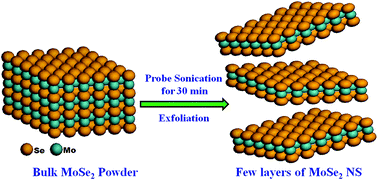Sonochemical synthesis of a 2D–2D MoSe2/graphene nanohybrid electrode material for asymmetric supercapacitors†
Abstract
Molybdenum selenide (MoSe2) nanosheets are prepared by a simple and facile sonochemical route. To optimize the synthesis process, the sonication is tested at three different time durations (15, 30 and 45 min) with a constant power of 500 W. In order to improve the electrochemical performance of the exfoliated MoSe2 nanosheets, we report the hybridization of 2D-MoSe2 with 2D-graphene by a simple solvothermal method. The exfoliated MoSe2 nanosheets are perpendicularly oriented on the surface of the graphene nanosheets. These MoSe2 nanosheet edges have a large number of electrochemically active sites, and the graphene sheets provide effective mass transportation of ions at the electrode–electrolyte interface. Cyclic voltammetry reveals the pseudocapacitive behaviour of a MoSe2/graphene nanohybrid based electrode. From galvanostatic charge–discharge studies, the specific capacitance is found to be 945 F g−1 at a current density of 1 A g−1. An asymmetric supercapacitor (ASC) device is fabricated, which delivers a specific capacitance of 75 F g−1 (@1 A g−1) with an energy density of 26.6 W h kg−1 and a power density of 0.8 kW kg−1, and it retains 88% of its capacitance even after 3000 cycles.



 Please wait while we load your content...
Please wait while we load your content...